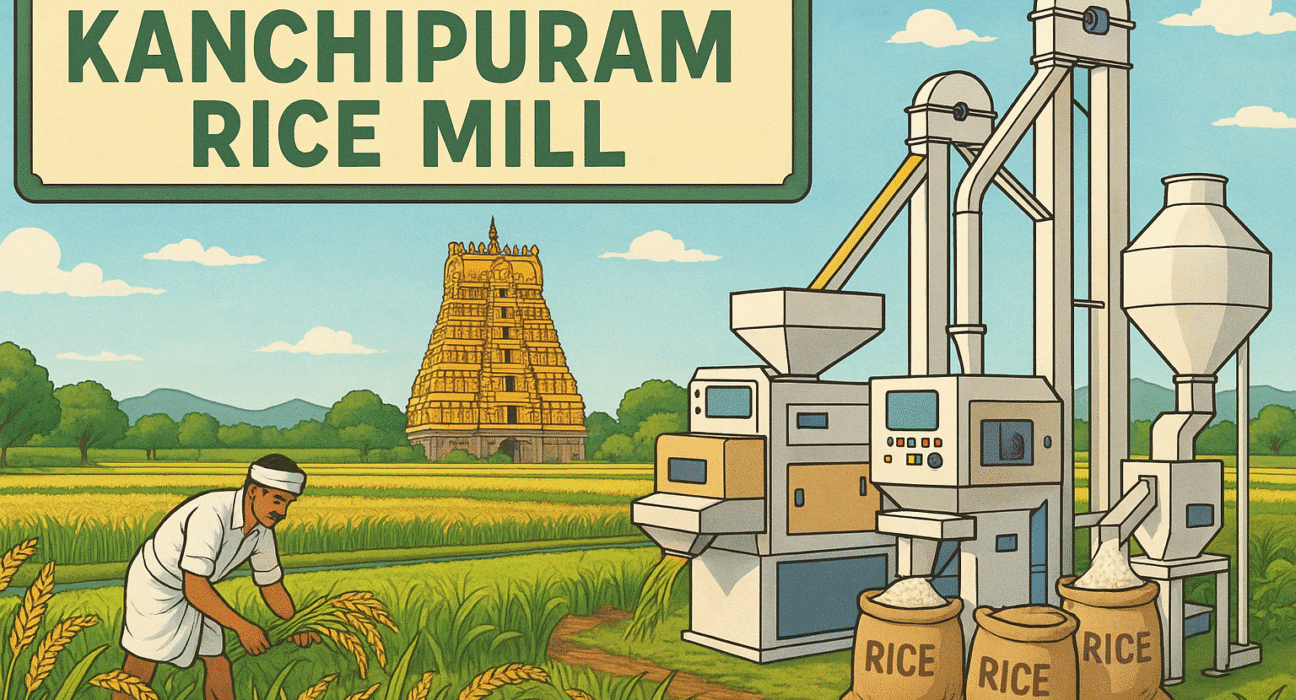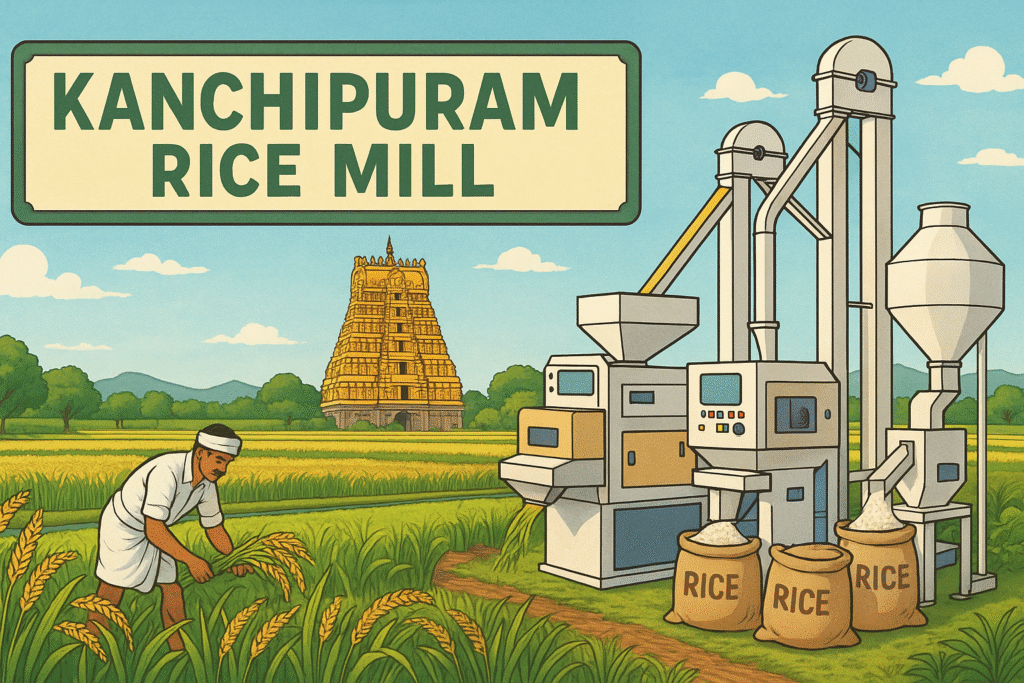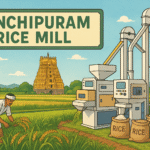The Heartbeat of Kanchipuram’s Agriculture: Rice Mills, Their Significance, and the Challenges They Face

Rice has been the cornerstone of Tamil Nadu’s agricultural economy for centuries, and nowhere is this more evident than in Kanchipuram district. Known globally for its ancient temples and exquisite silk sarees, Kanchipuram also holds a distinguished position as one of Tamil Nadu’s most important rice processing hubs. With 56 private rice mills operating at full capacity, each processing approximately 7,500 metric tonnes of paddy annually, the district represents a thriving ecosystem that bridges the gap between farmers and consumers.

This network of rice mills doesn’t just process grain—it serves as the economic backbone for thousands of farming families while ensuring food security for millions across Tamil Nadu and beyond. From the bustling facilities of KVS Modern Rice Mill to the established operations of Sri Varalakshmi Modern Rice Mill, these processing centers have evolved into sophisticated operations that combine traditional knowledge with modern technology.
The Economic Powerhouse: Why Rice Mills Matter in Kanchipuram
Driving Local Economic Growth
The rice milling industry in Kanchipuram contributes significantly to both local and state economies. Agriculture serves as the greatest contributor to Kanchipuram’s economy, with rice mills playing a pivotal role in value addition. These facilities collectively process hundreds of thousands of tonnes of paddy annually, creating a ripple effect that benefits the entire regional economy.
Rice mills in the district are strategically important because farmers depend on rice mills for right price and timely distribution1. This dependency creates a symbiotic relationship where mills ensure farmers receive fair compensation while maintaining steady supply chains for consumers. The rice milling cluster in Madurantakam block, in particular, points to the critical importance of these industries in the district’s economic framework.
Employment Generation and Rural Development
The rice milling sector provides direct employment to thousands of workers across Kanchipuram district. Each mill typically employs 21-50 workers, from machine operators to quality control specialists, administrative staff, and logistics personnel. When considering the 56 operational mills, the direct employment figure easily exceeds 2,000 jobs, with indirect employment reaching much higher numbers.
The economic impact extends beyond direct employment. Rice millers contribute 26.42% to value addition in the rice production chain, making them crucial intermediaries in the agricultural value system. This substantial value addition translates to increased economic activity in transportation, storage, marketing, and related services.
Food Security and Supply Chain Stability
Rice mills in Kanchipuram serve as critical nodes in Tamil Nadu’s food security infrastructure. The state procures approximately 40 lakh tonnes of paddy annually, and a significant portion flows through processing facilities like those in Kanchipuram. These mills ensure consistent supply to both the Public Distribution System (PDS) and open markets, maintaining price stability and availability.
The strategic location of Kanchipuram’s rice mills, with proximity to Chennai port and major transportation networks, makes them valuable for both domestic distribution and export operations1. The district’s rice processing capabilities contribute to Tamil Nadu’s position as a major rice-producing state that contributes 43% of total food grains production.
The Machinery Behind the Magic: Equipment Used in Modern Rice Mills

Modern rice mills in Kanchipuram employ sophisticated equipment that transforms raw paddy into polished rice through multiple precisely controlled stages. Understanding this equipment provides insight into the technological advancement and investment required in contemporary rice processing.
Pre-Processing Equipment
Paddy Pre-Cleaners form the first line of processing, removing chaff, straw bits, and other impurities from raw paddy. These machines typically include grain elevators, aspirators, and flat graders with capacities ranging from 250 kg/hr to 4,000 kg/hr9. The double-deck paddy cleaners can process between 10,000 to 12,000 kg/hr, making them suitable for large-scale operations9.
Destoners represent crucial equipment that separates stones and heavy impurities from grains using bulk density differences. These machines ensure rice quality by removing potentially damaging foreign materials that could affect both processing equipment and final product quality.
Core Processing Machinery
Paddy Huskers remove the outer husk from paddy grains to produce brown rice. Modern mills use rubber roller engagement huskers that provide efficient husking while minimizing grain breakage. These machines typically operate at capacities of 2-7 tonnes per hour, depending on the model.
Paddy Separators perform the critical function of separating unhusked paddy from brown rice after the husking process. Using oscillating-type mechanisms with high sorting performance, these machines divide the mixture into three distinct classes: paddy, mixed paddy and brown rice, and pure brown rice.
Rice Whiteners and Polishers transform brown rice into the white rice familiar to consumers. Modern mills employ multiple types including:
- Abrasive whiteners that remove bran layers through friction
- Friction-type polishers that provide final finishing
- Water jet silky polishers that enhance appearance and reduce broken rice
Quality Control and Finishing Equipment
Color Sorters represent the pinnacle of quality control technology, using optical sensors and AI-driven systems to detect and remove discolored, damaged, or foreign materials from rice. Advanced models can achieve near-perfect purity with real-time defect detection.
Rice Graders ensure uniformity by sorting rice grains based on size, while length graders separate rice by length specifications, crucial for premium market segments.
Support Systems and Infrastructure
Modern rice mills require comprehensive support systems including:
- Bucket elevators and conveyors for material transport between processing stages
- Boilers and dryers for moisture control and steam generation
- Dust collection systems for maintaining clean working environments
- Automatic packaging machinery for efficient final product handling
- Silo storage systems for both raw material and finished product storage
Advanced mills incorporate PLC-based control systems with HMI touch screens, allowing operators to monitor and adjust processing parameters in real-time, ensuring optimal efficiency and quality.
Challenges Confronting Rice Millers: Traditional Problems in a Modern Industry
Despite technological advances and economic importance, rice mills in Kanchipuram face numerous operational, financial, and structural challenges that impact their efficiency and profitability.
Technical and Operational Challenges
Equipment Maintenance and Breakdowns represent ongoing concerns for mill operators. Common technical problems include:
- Excessive machine vibration caused by improper installation, insufficient anti-vibration technology, or uneven foundations
- Belt slippage and misalignment affecting power transmission and reducing operational efficiency
- Bearing failures due to inadequate lubrication or prolonged operation without maintenance
- Grinding roller wear requiring regular replacement to maintain rice quality
Quality Control Issues significantly impact miller profitability:
- High grain breakage rates caused by excessive pressure, improper machine settings, or high moisture content in raw materials
- Inadequate bran removal systems leading to uneven pressure on rice grains and increased processing time
- Color sorting inefficiencies when mills lack advanced optical sorting equipment
- Contamination from stones and foreign materials when destoning equipment malfunctions
Raw Material and Storage Challenges
Moisture Content Variability poses significant operational challenges. The ideal moisture content in paddy is around 14%, but weather conditions can cause fluctuations between 10-21%, particularly during monsoon periods. Higher moisture levels increase breakage rates and can cause equipment lockups, while lower moisture reduces yield.
Storage and Spoilage Problems affect both input and output materials:
- Paddy spoilage rates of 4-6% due to inadequate storage facilities and exposure to adverse weather
- Lack of proper drying facilities forcing farmers to deliver high-moisture paddy to mills
- Storage space constraints particularly during peak harvest seasons
- Pest and rodent damage in poorly maintained storage facilities
Financial and Market Pressures
Fluctuating Paddy Prices create significant business uncertainty. Price instability makes it difficult for millers to plan operations and maintain consistent profit margins. This volatility is compounded by competition from larger industrial players who benefit from economies of scale.
Rising Operational Costs strain miller finances:
- Labor shortage and increased wage costs as agricultural workers migrate to urban employment or MGNREGA schemes
- Electricity and fuel cost increases affecting operational margins
- Transportation costs particularly when mills must deliver processed rice to distant FCI godowns
Working Capital Constraints affect smaller mills’ ability to:
- Purchase adequate raw materials during harvest seasons
- Invest in equipment upgrades and maintenance
- Weather market fluctuations and delayed payments
Regulatory and Infrastructure Challenges
Government Policy Changes create operational uncertainties. Mills processing paddy for government agencies face challenges with:
- Delayed payments from procurement agencies
- Changing specifications for PDS rice quality requirements
- Transportation cost burden when mills must deliver to designated storage facilities
Infrastructure Limitations hamper efficiency:
- Inadequate transportation networks during peak seasons
- Power supply irregularities affecting continuous operations
- Limited access to modern technology particularly for smaller, traditional mills
Environmental and Sustainability Pressures
Environmental Compliance requirements increasingly challenge traditional operations:
- Waste management of rice hulls and bran requires proper disposal systems
- Dust and noise pollution control measures demand additional investment
- Water usage optimization for wet processing methods needs improvement
- Energy efficiency mandates require equipment upgrades
Labor and Skills Challenges
Skilled Labor Shortage affects mill operations as many mill owners do not supervise and train their operators adequately. This leads to:
- Suboptimal machine settings reducing head rice yield
- Increased breakdown frequency due to improper operation
- Quality inconsistencies affecting market competitiveness
- Safety concerns in poorly supervised environments
Seasonal Labor Fluctuations particularly affect mills during peak processing periods when demand for agricultural labor across all sectors intensifies.
The Path Forward: Modernization and Adaptation
Despite these challenges, rice mills in Kanchipuram are adapting through technology adoption, cooperative approaches, and government support initiatives. The Tamil Nadu government’s plan to establish integrated modern rice mills through public-private partnerships represents recognition of the sector’s importance and the need for modernization.
The future of rice milling in Kanchipuram lies in balancing traditional strengths with modern innovations. Advanced IoT integration, automation, and data-driven efficiency systems are transforming the industry globally. Mills that successfully adopt these technologies while maintaining their crucial role in the local agricultural ecosystem will continue to serve as the heartbeat of Kanchipuram’s rice economy.
The 56 rice mills of Kanchipuram stand as testimony to the district’s agricultural heritage and economic dynamism. As they navigate modern challenges while preserving their essential function in Tamil Nadu’s food system, these mills continue to demonstrate the vital connection between traditional agriculture and contemporary food security. Their success directly impacts not only the livelihoods of thousands but also the broader goal of sustainable agricultural development in one of India’s most important rice-producing regions.







